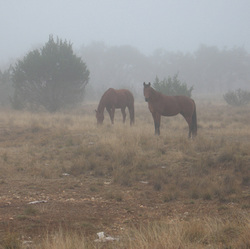Good Now Bad Later Why Does This Happen?
July 10, 2014
Written by: Josh Lyons & Keith Hosman
Written by: Josh Lyons & Keith Hosman
|
When you train your horse, both of you have to sweat. And you have to stay focused. Keep Flicka going on a specific exercise(s) and keep her going consistently until you see improvement. When you get on your horse to train it, you've got a job to do. It's your mission to see some improvement, no matter how small, before you get off. After all, if you're training, you're not joy riding. Joy riding is when you're walking down the trail, laughing and hanging out with your friends and your horse is traveling on a loose rein. Joy rides happen after - and because of - your training and hard work.
Why is your horse good today, bad tomorrow? To understand that, you need to understand the horse's learning as explained here. 
It's all the hard work you do that gets you to the point where you're safely able to go out and trail ride or show your horse.
How long should you train when you do climb up there? The simple answer is that it's not the amount of time spent that trains your horse; its' the quality of time. It's not a matter of riding your horse a certain number of times per week for a particular amount of time. It's how consistent you are when you ride. "Consistency" means you don't stop after two minutes and talk to friends. It means you maintain your concentration. It means you do the exercise, pause a couple of seconds, then repeat it... over and over and over. In the beginning you won't see much improvement - but that's to be expected. You need to keep pushing that horse to focus and make a change. If you don't go long enough, then you've done the same thing (the exercise or movement) over and over - but not enough to have caused a change. Remember, your horse is learning a movement when he's doing it wrong, not when he's doing it right. That's the funny part. It's when he's doing it wrong that he's learning it. If you come out pick up the reins and the horse just accidentally stumbles upon what it is you wanted him to do, then the horse doesn't really know what he did that was right. But if he pulls for an hour, pulling up, pulling down, speeding up, slowing down, doing everything he can think of, then he finally finds, when I release, that he's found the answer. What he's learned is that all the mistakes he made are not the answer. The longer it takes, the better he'll have learned it in the end.
Every time you teach an exercise, your horse will go through the same learning cycle. He'll go from "Bad" to "Good" to "Worse" to "Not So Bad" to "Learned." That's the typical cycle: Bad. Good. Worse. Not so bad. Learned. You know "Good." "Good" is where we get excited. It's the part where we want to show off to our friends. We want to show somebody how soft our horse has become, so we walk over to brag to somebody, pick up our reins and the horse sticks his nose straight out, stiff as a board. We're embarrassed and our friends snicker. We've just entered the "worse" stage. It's the part where "he was getting it but now he's not." Tip: Teach almost anything to your horse with the "Clock Work Exercise." That's a chapter in the basic training book "What I'd Teach Your Horse" - and you can hear the whole section right now for FREE on audio when you click here.
It's during the "worse" part where we typically second-guess our training. "The horse was good but now he's worse. I must be doing something wrong." You begin to think you need to change what you're doing. "Maybe my hand's in the wrong position" or "I'm using too little pressure." You begin to think you're doing something that's not correct. That's when we're most likely to change what we're doing. But that's the most important time for us to not change, to keep on doing what we're doing. You've got to get through this stage by being consistent. Keep doing the same thing over and over so that the horse realizes all the movements that are "mistakes" and which single movement is correct. It's consistency and time that teach your horse.
So, it'll go from bad to good to worse and then to "not so bad." During this period he'll do okay - but not as good as before. You'll be thinking "He's not as bad as he was yesterday; he's certainly better - but he's not as good as he was just 10 minutes ago." Keep pushing through to the final stage: "Learned." At the end of the cycle your horse will actually have learned the exercise. And you will have had to go through all of the stages before arriving here - otherwise, he's never actually learned it. If sometimes your horse comes to you and sometimes he doesn't, if she sometimes bucks but sometimes doesn't, then your horse was never pushed through it's training to the final stage of "learned." There are just four thing you need to train your horse.. Do you know what those four things are? Click here to find out what they are!Print this article:
|
| ||||||

